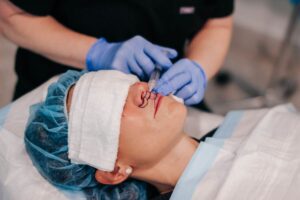
One of the most frequent questions I get when talking to a patient about a procedure or surgery is, “How much is it going to hurt?” No one wants to be in pain regardless of whether it is a small injection or hours-long procedure. At the same time, with the growing opioid crisis, many are afraid of taking pain medication.
Much of my research in residency centered around this very topic – managing pain before, during, and after head and neck procedures. Feeling as comfortable as possible is my top priority for all patients since I want them to have the best experience possible. I’d like to share a few simple steps I like to take in making this happen.
Managing Anxiety
For many, the worst part about having a cosmetic procedure is the anticipation. This can carry over to how your body reacts to pain as well. For in-office procedures, I like to offer Valium for those who are particularly anxious. Valium is a benzodiazepine medication that acts very similarly on receptors in the body to alcohol. It “takes the edge off” from the anxieties of the hour or so before the procedure. Because of this, you must have a ride to and from the office when opting to use this medication before a procedure. Another thing I like to do to ease tension is placing an aromatherapy-infused cool towel over your eyes just before preparing your face for a procedure. This small step calms the muscles around the eyes to instantly relieve tension, keeps you from seeing any local anesthetic being injected, and keeps the lights in the ceiling out of your eyes.
Topical Numbing Ointment
Not all topical numbing agents are created equally. After using numerous products, the main takeaway is that ointments are better than creams. Oil-based ointments penetrate the skin much faster and better than water-based creams. Topical agents also need time to take effect. At a minimum they need to stay on about 30 min but keep working better if kept on even longer. The formulation we use in our office must be custom made by a compounding pharmacy and is 20% benzocaine, 10% lidocaine, 10% tetracaine. This formulation is otherwise known as BLT ointment. Works like a charm!
Nitrous Oxide
Nitrous oxide has been used for years in dental offices and is otherwise known as “laughing gas.” It has become increasingly popular in cosmetic offices to control pain during laser treatments, injections, and small surgical procedures. The most popular devices currently are Nitronox and Pronox. Both work in the exact same way but are sold by different companies and combine nitrous oxide with oxygen in a self-administered mouthpiece. This is an on-demand system meaning that gas only flows through the tube when you inhale through the mouthpiece which further improves safety. Nitrous oxide has properties that improve anxiety (anxiolytic) and reduce pain (analgesic). I often will have patients use Nitronox prior to injection with local anesthetic to help with any pain from the needle sticks. Once the local anesthetic takes effect it is not longer needed since the area is numb. For longer procedures, it can be repeated to improve comfort throughout the whole process. Because nitrous oxide is metabolized so quickly, it does not require you having a ride to and from the office. By the time you leave the office it is already out of your system.
Regional Anesthesia
A huge part of the sensory portion of the brain focuses on sensation in the head and neck which is why it can be more sensitive than other parts of the body. Luckily, most of this sensation comes from distinct nerve bundles that are in predictable locations. In all my procedures, whether they are in the operating room or in the clinic, I perform nerve blocks on these nerve fibers to numb entire regions of the face without having to use a large amount of fluid. There are 2 types of medications generally used in local anesthesia – lidocaine and bupivacaine. Lidocaine starts to work a lot more quickly but wears off faster, whereas bupivacaine takes longer to take effect but lasts much longer. I generally mix these two medications so that the solution I’m injecting takes effect quickly but has long-lasting effects to keep you comfortable for the entire day of surgery.
Much of the research I focused on in my training centered on regional anesthesia for head and neck procedures. During that time, I discovered that performing nerve blocks prior to a procedure under general anesthesia reduced overall pain and the need for pain medication AFTER surgery. Your body registers pain even while asleep and can even be seen on the monitor as elevated heart rate. When proper regional anesthesia is done a few changes happen. First, fewer medications are given while you are asleep leading to less nausea and a more comfortable wakeup from anesthesia. Second, the body’s pain response was never revved up while the procedure was taking place. It’s as if the brain was tricked into not having quite as much pain. Since I’ve started performing nerve blocks on all my patients it is rare that I have a patient that needs narcotic pain medication past 1-2 days if at all.
Post-Procedure Pain Medication
It is inevitable that many will need narcotic pain medications after surgery, such as oxycodone, in the short term. I still give prescriptions for surgical patients routinely; however, I am still skeptical that they are as effective in pain management as NSAIDs and acetaminophen. NSAIDs (nonsteroidal anti-inflammatory drugs) such as Advil, ibuprofen, Naproxen, and Aleve are a class of over-the-counter medications that target inflammation. In my opinion, inflammation is the primary cause of postsurgical pain. For the longest time they were avoided after surgery since it was feared that their blood thinning properties would lead to a higher rate of bleeding after surgery (hematomas). Within the last decade there have been countless studies to prove that this isn’t the case. I have found that if someone is taking medications that thin the blood BEFORE surgery then there can be more bleeding during surgery and more bruising. I have not seen this same thing if taken after surgery. Both ibuprofen and acetaminophen can be taken every 4 hours, so I usually tell my patients to alternate them every two hours. For example, take ibuprofen at noon followed by acetaminophen at 2pm then ibuprofen again at 4pm, etc. Time and time again patients call me saying their pain medication isn’t working. Every time I ask, “Are you also taking Tylenol and ibuprofen?” If the answer is “no” inevitably they are better several hours later after they have started this regimen rather than increasing narcotic dosage. Everyone is different when it comes to feeling pain, so I don’t want anyone feeling uncomfortable after surgery. Much of what I have seen, though, is that narcotics make people sleepy, so they fall asleep and no longer care about the pain. Recovering from surgery is difficult enough. Why would you want to add being constipated and drowsy if you don’t need to?
If you’re interested in learning more about facial surgery done in either of our downtown Austin or Dallas, TX offices head to our YouTube channel.
To schedule your consultation with Dr. Saxon to determine if one or both of these procedures may be right for you click here or reach out to us via phone at (512) 866-8039 or email: info@saxonmd.com.

